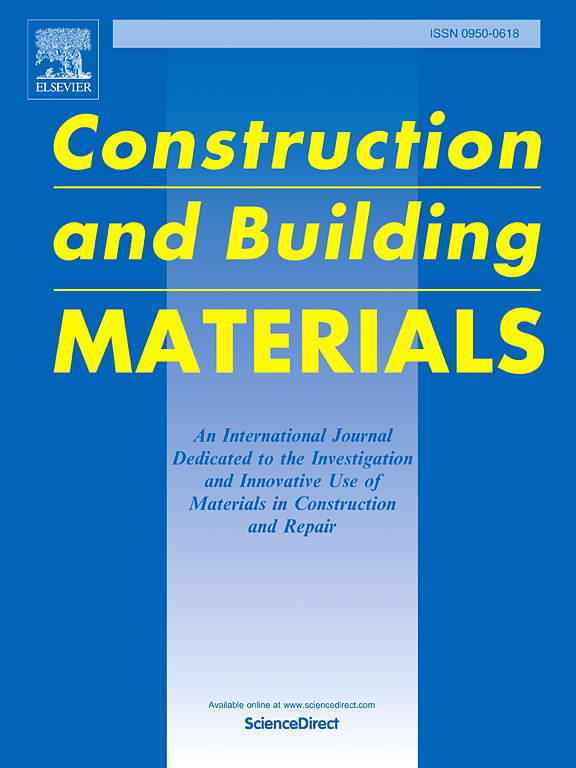Low carbon footprint lightweight GPM production: Optimization of carbon fiber and hydrogen peroxide
IF 7.4
1区 工程技术
Q1 CONSTRUCTION & BUILDING TECHNOLOGY
引用次数: 0
Abstract
This study examines the effects of using Carbon Fiber (CF) and Hydrogen Peroxide (H2O2) on the mechanical and thermal properties of ground Raw Perlite (RP) based Geopolymer Mortar (GPM). It focuses on determining the optimal dosages of CF and H2O2. This study aims to make perlite-based GPMs that form strong bonds with alkali activators lightweight, while also improving their compressive, tensile, flexural, and thermal properties. Sodium Silicate (Na2SiO3) and Sodium Hydroxide (NaOH) were used as alkali activators, while H2O2 served as the foaming agent. The NaOH solution was 13 M, and Na2SiO3 was used with a 2-module specification. In this context, a reference GPM was prepared using RP and Crushed Sand (CS). CF was chosen for its advantages, such as low density, high Young's modulus and tensile strength. Various amounts of CF and H2O2 were used to determine the optimal dosage to achieve a durable and lightweight mortar. The results showed that the best performance was achieved with 1 % CF and 1 % H2O2. Compressive strength increased to around 3.5 MPa with the addition of 2 % H2O2 and 2 % CF. It was found that the use of CF provided significant protection in compressive and flexural strength, but increasing the fiber weight or volume ratio beyond a certain dosage could decrease strength efficiency. These findings support the use of 6 mm CF as a reinforcing material in GPMs within the construction industry while emphasizing the need to avoid exceeding a 2 % H2O2 ratio. The results of this research can be considered an important step toward developing environmentally friendly and durable building materials.
低碳足迹轻质GPM生产:碳纤维和过氧化氢的优化
本研究考察了使用碳纤维(CF)和过氧化氢(H2O2)对地面生珍珠岩(RP)基地聚合物砂浆(GPM)的力学和热性能的影响。重点是确定CF和H2O2的最佳用量。这项研究的目的是使珍珠岩基gpm与碱活化剂形成牢固的结合,同时改善其压缩、拉伸、弯曲和热性能。以水玻璃(Na2SiO3)和氢氧化钠(NaOH)为碱活化剂,H2O2为发泡剂。NaOH溶液为13 M, Na2SiO3以2模块规格使用。在此背景下,采用RP和破碎砂(CS)制备了参考GPM。选用CF具有密度低、杨氏模量高、抗拉强度高等优点。通过使用不同量的CF和H2O2来确定最佳用量,以获得耐用且轻质的砂浆。结果表明,在1 % CF和1 % H2O2条件下,反应效果最佳。加入2 % H2O2和2 % CF后,抗压强度可提高到3.5 MPa左右,CF对抗压和抗弯强度有明显的保护作用,但超过一定剂量后纤维重量或体积比的增加会降低强度效率。这些研究结果支持在建筑行业的gpm中使用6 mm CF作为增强材料,同时强调需要避免超过2 % H2O2的比例。这项研究的结果可以被认为是开发环保和耐用建筑材料的重要一步。
本文章由计算机程序翻译,如有差异,请以英文原文为准。
求助全文
约1分钟内获得全文
求助全文
来源期刊

Construction and Building Materials
工程技术-材料科学:综合
CiteScore
13.80
自引率
21.60%
发文量
3632
审稿时长
82 days
期刊介绍:
Construction and Building Materials offers an international platform for sharing innovative and original research and development in the realm of construction and building materials, along with their practical applications in new projects and repair practices. The journal publishes a diverse array of pioneering research and application papers, detailing laboratory investigations and, to a limited extent, numerical analyses or reports on full-scale projects. Multi-part papers are discouraged.
Additionally, Construction and Building Materials features comprehensive case studies and insightful review articles that contribute to new insights in the field. Our focus is on papers related to construction materials, excluding those on structural engineering, geotechnics, and unbound highway layers. Covered materials and technologies encompass cement, concrete reinforcement, bricks and mortars, additives, corrosion technology, ceramics, timber, steel, polymers, glass fibers, recycled materials, bamboo, rammed earth, non-conventional building materials, bituminous materials, and applications in railway materials.
 求助内容:
求助内容: 应助结果提醒方式:
应助结果提醒方式:


